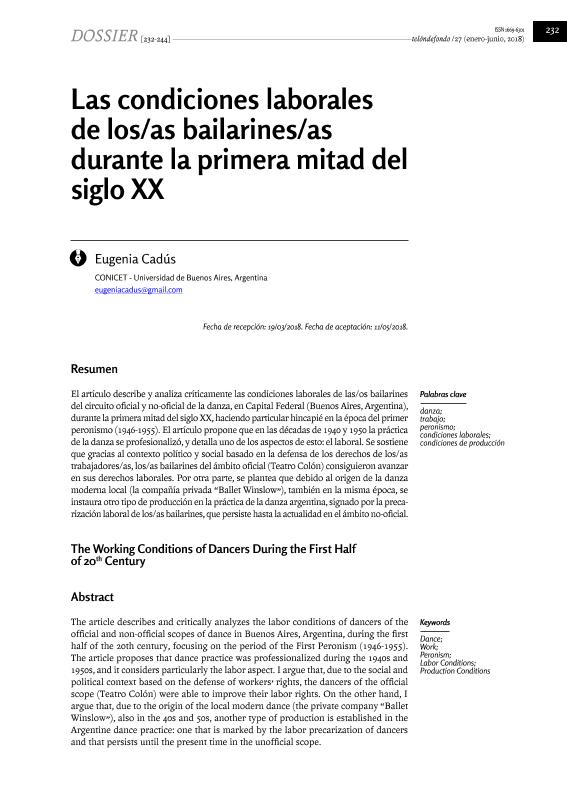Mostrar el registro sencillo del ítem
dc.contributor.author
Cadús, María Eugenia

dc.date.available
2022-11-09T14:57:28Z
dc.date.issued
2018-12
dc.identifier.citation
Cadús, María Eugenia; Las condiciones laborales de los/as bailarines/as durante la primera mitad del siglo XX; Universidad de Buenos Aires. Facultad de Filosofía y Letras. Instituto de Historia del Arte Latinoamericano y Argentino; Telondefondo; 27; 12-2018; 232-244
dc.identifier.issn
1669-6301
dc.identifier.uri
http://hdl.handle.net/11336/177055
dc.description.abstract
El artículo describe y analiza críticamente las condiciones laborales de las/os bailarines del circuito oficial y no-oficial de la danza, en Capital Federal (Buenos Aires, Argentina), durante la primera mitad del siglo XX, haciendo particular hincapié en la época del primer peronismo (1946-1955). El artículo propone que en las décadas de 1940 y 1950 la práctica de la danza se profesionalizó, y detalla uno de los aspectos de esto: el laboral. Se sostiene que gracias al contexto político y social basado en la defensa de los derechos de los/as trabajadores/as, los/as bailarines del ámbito oficial (Teatro Colón) consiguieron avanzar en sus derechos laborales. Por otra parte, se plantea que debido al origen de la danza moderna local (la compañía privada “Ballet Winslow”), también en la misma época, se instaura otro tipo de producción en la práctica de la danza argentina, signado por la precarización laboral de los/as bailarines, que persiste hasta la actualidad en el ámbito no-oficial.
dc.description.abstract
The article describes and critically analyzes the labor conditions of dancers of the official and non-official scopes of dance in Buenos Aires, Argentina, during the first half of the 20th century, focusing on the period of the First Peronism (1946-1955). The article proposes that dance practice was professionalized during the 1940s and 1950s, and it considers particularly the labor aspect. I argue that, due to the social and political context based on the defense of workers’ rights, the dancers of the official scope (Teatro Colón) were able to improve their labor rights. On the other hand, I argue that, due to the origin of the local modern dance (the private company “Ballet Winslow”), also in the 40s and 50s, another type of production is established in the Argentine dance practice: one that is marked by the labor precarization of dancers and that persists until the present time in the unofficial scope.
dc.format
application/pdf
dc.language.iso
spa
dc.publisher
Universidad de Buenos Aires. Facultad de Filosofía y Letras. Instituto de Historia del Arte Latinoamericano y Argentino
dc.rights
info:eu-repo/semantics/openAccess
dc.rights.uri
https://creativecommons.org/licenses/by-sa/2.5/ar/
dc.subject
DANZA
dc.subject
TRABAJO
dc.subject
PERONISMO
dc.subject
CONDICIONES LABORALES
dc.subject
CONDICIONES DE PRODUCCION
dc.subject.classification
Arte, Historia del Arte

dc.subject.classification
Arte

dc.subject.classification
HUMANIDADES

dc.title
Las condiciones laborales de los/as bailarines/as durante la primera mitad del siglo XX
dc.title
The Working Conditions of Dancers During the First Half of 20th Century
dc.type
info:eu-repo/semantics/article
dc.type
info:ar-repo/semantics/artículo
dc.type
info:eu-repo/semantics/publishedVersion
dc.date.updated
2022-11-08T14:01:42Z
dc.journal.number
27
dc.journal.pagination
232-244
dc.journal.pais
Argentina

dc.journal.ciudad
Ciudad Autónoma de Buenos Aires
dc.description.fil
Fil: Cadús, María Eugenia. Consejo Nacional de Investigaciones Científicas y Técnicas; Argentina. Universidad de Buenos Aires. Facultad de Filosofía y Letras. Departamento de Artes; Argentina
dc.journal.title
Telondefondo
dc.relation.alternativeid
info:eu-repo/semantics/altIdentifier/url/http://revistascientificas.filo.uba.ar/index.php/telondefondo/article/view/5101
dc.relation.alternativeid
info:eu-repo/semantics/altIdentifier/doi/https://doi.org/10.34096/tdf.n27.5101
Archivos asociados
